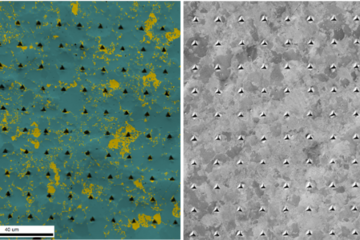All genres
2201.
Poster
Ab initio study of nano-precipitate nucleation and growth in ferritic steels. Materials Discovery by Scale-Bridging High-Throughput Experimentation and Modelling, Ruhr-Universität Bochum, Bochum, Germany (2010)
2202.
Poster
Ab initio and kinetic Monte-Carlo study of nano-precipitate nucleation and growth in ferritic steels. Materials Discovery by Scale-Bridging High-Throughput Experimentation and Modelling, Bochum, Germany (2010)
2203.
Poster
Kinetic Monte Carlo and ab initio study of nano-precipitates and growth in ferritic steels. Ab Initio Description of Iron and Steel: Mechanical Properties, Tegernsee, Germany (2010)
2204.
Poster
Quantum-mechanics-based study of multi-scale elastic properties of hierarchical biocomposites. Prospects of bionics for functional Materials Science, Montan University Leoben, Leoben, Austria (2010)
2205.
Poster
Enhancing mechanical properties of calcite by Mg substitutions: An ab initio study. Psi-k Conference 2010, Berlin, Germany (2010)
2206.
Poster
Influence of Structural Organization and Mineral Distribution on the Local Mechanical Properties of Mineralized Cuticle. Workshop Prospects in BIONICS, Leoben, Austria (2010)
2207.
Poster
Ab initio based study of multi-scale elastic properties of hierarchical biocomposites. Psi_k Conference 2010, Berlin, Germany (2010)
2208.
Poster
Structure of the 3D-Photonic Crystals in the Multi-Colored Scales of the Weevil Entimus imperialis (Curculionidae). Ninth International Conference on Photonic and Electromagnetic Crystal Structures (PECS-IX 2010), Granada, Spain (2010)
2209.
Poster
Identification of fundamental materials-design limits in ultra light-weight Mg–Li alloys via quantum-mechanical calculations. Materials Science and Engineering 2010, Darmstadt, Germany (2010)
2210.
Poster
Arthropod cuticle: A biological multi-functional composite used as template for nano-to-macro-scale hierarchical modeling. Materials Science and Engineering 2010, Darmstadt, Germany (2010)
2211.
Poster
Study of local chemical gradients in advanced precipitation hardened TRIP steel. 52nd International Field Emission Symposium IFES 2010, Sydney, Australia (2010)
2212.
Poster
Structural organization and mineral distribution in load-bearing exoskeleton parts of the edible crab Cancer pagurus. DPG Frühjahrstagung 2010, Regensburg, Germany (2010)
2213.
Poster
Analysis of Deformation Mechanisms in Gamma-TiAl by Nanoindentation Experiments and Crystal Plasticity Simulations. Nanobrücken -- Nanomechanical Testing Workshop and Hysitron User Meeting, Saarbrücken, Germany (2010)
2214.
Poster
Influence of Structural Organization and Mineral Distribution on the Local Mechanical Properties of Mineralized Cuticle from the Crab Cancer pagurus. Materials Science and Engineering MSE 2010, Darmstadt, Germany (2010)
2215.
Poster
Effect of interstitials on vacancy formation and mobility in metals. Summer School: Computational Materials Science, San Sebastian, Spain (2010)
2216.
Poster
Combined ab initio studies and kinetic Monte Carlo simulations of nano-precipitation in ferritic steels. Summer School: Computational Materials Science, San Sebastian, Spain (2010)
2217.
Poster
Spectral and angular distribution of light scattered from the elytra of two carabid beetle species. First NanoCharm Workshop on Advanced Polarimetric Instrumentation, Ecole Polytechnique, Palaiseau Cedex, Palaiseau Cedex, France (2009)
2218.
Poster
Three dimensional characterization of microstructure of an ultra fine- grained Cu–0.17wt%Zr. 1st MACAN 2009, Berlin, Germany (2009)
2219.
Poster
Effect of grain refinement on strength and toughness in dual-phase steels. 2nd International Symposium on Steel Science ISSS 2009, Kyoto, Japan (2009)
2220.
Poster
Microstructural evolution during hot working of 1.4362 duplex stainless steel. 2nd International Symposium on Steel Science (ISSS 2009), Kyoto, Japan (2009)











